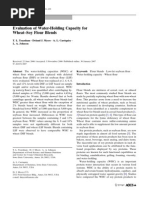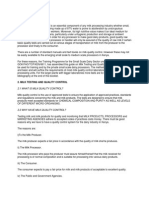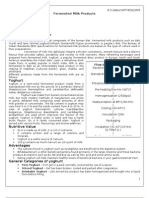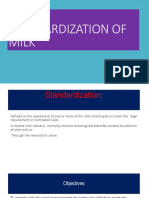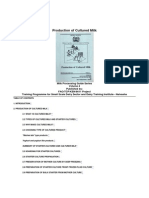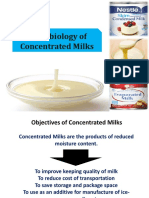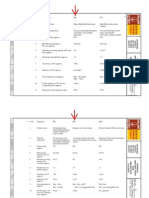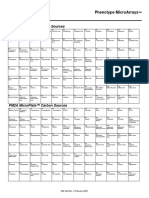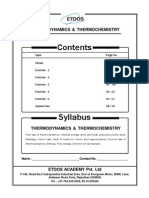0 ratings0% found this document useful (0 votes)
965 viewsFat, Acidity, LR, SNF, TS, Apt, Cob
Fat, Acidity, LR, SNF, TS, Apt, Cob
Uploaded by
Sahar SanwalThis document provides information on the Clot on Boiling (COB) test used to determine the heat stability of milk. The COB test involves heating a milk sample to boiling - if the sample coagulates, it indicates advanced acidification making the milk unsuitable for processing. The test is performed when milk arrives at a processing plant, and any milk that fails is rejected. The test principle is that increased acidity from microbial activity makes milk proteins more heat sensitive and likely to coagulate upon boiling. The standard is that COB should be negative for all fluid milk types. The document also provides details on procedures, observations, applicability, reagents, equipment, and references for the COB test.
Copyright:
© All Rights Reserved
Available Formats
Download as PDF, TXT or read online from Scribd
Fat, Acidity, LR, SNF, TS, Apt, Cob
Fat, Acidity, LR, SNF, TS, Apt, Cob
Uploaded by
Sahar Sanwal0 ratings0% found this document useful (0 votes)
965 views9 pagesThis document provides information on the Clot on Boiling (COB) test used to determine the heat stability of milk. The COB test involves heating a milk sample to boiling - if the sample coagulates, it indicates advanced acidification making the milk unsuitable for processing. The test is performed when milk arrives at a processing plant, and any milk that fails is rejected. The test principle is that increased acidity from microbial activity makes milk proteins more heat sensitive and likely to coagulate upon boiling. The standard is that COB should be negative for all fluid milk types. The document also provides details on procedures, observations, applicability, reagents, equipment, and references for the COB test.
Original Description:
basic tests required to test milk
Original Title
Fat, Acidity, Lr, Snf, Ts, Apt, Cob
Copyright
© © All Rights Reserved
Available Formats
PDF, TXT or read online from Scribd
Share this document
Did you find this document useful?
Is this content inappropriate?
This document provides information on the Clot on Boiling (COB) test used to determine the heat stability of milk. The COB test involves heating a milk sample to boiling - if the sample coagulates, it indicates advanced acidification making the milk unsuitable for processing. The test is performed when milk arrives at a processing plant, and any milk that fails is rejected. The test principle is that increased acidity from microbial activity makes milk proteins more heat sensitive and likely to coagulate upon boiling. The standard is that COB should be negative for all fluid milk types. The document also provides details on procedures, observations, applicability, reagents, equipment, and references for the COB test.
Copyright:
© All Rights Reserved
Available Formats
Download as PDF, TXT or read online from Scribd
Download as pdf or txt
0 ratings0% found this document useful (0 votes)
965 views9 pagesFat, Acidity, LR, SNF, TS, Apt, Cob
Fat, Acidity, LR, SNF, TS, Apt, Cob
Uploaded by
Sahar SanwalThis document provides information on the Clot on Boiling (COB) test used to determine the heat stability of milk. The COB test involves heating a milk sample to boiling - if the sample coagulates, it indicates advanced acidification making the milk unsuitable for processing. The test is performed when milk arrives at a processing plant, and any milk that fails is rejected. The test principle is that increased acidity from microbial activity makes milk proteins more heat sensitive and likely to coagulate upon boiling. The standard is that COB should be negative for all fluid milk types. The document also provides details on procedures, observations, applicability, reagents, equipment, and references for the COB test.
Copyright:
© All Rights Reserved
Available Formats
Download as PDF, TXT or read online from Scribd
Download as pdf or txt
You are on page 1of 9
Clots on Boiling (COB) test of liquid milk Reference #
Used for: Practical implementation, for study Date:
and for reference.
Defination and explanation:
Acidity decreases the heat stability of milk. The clot-on- boiling test is used to determine
whether milk is suitable for processing, as it indicates whether milk is likely to coagulate during
processing (usually pasteurization). It is performed when milk is brought to the processing plant
— if the milk fails the test it is rejected.
The test measures the same characteristics as the alcohol test but is somewhat more lenient. It
has the advantage that no chemicals are needed. However, its disadvantage is that at high altitude
milk (and all liquids) boils at lower temperature and therefore the test is even more lenient.
Principle:
Acid developed in milk due to microbial activities during procuring, handling and transportation
of milk. This developed acid in milk make milk protein casein more heat sensitive so such milk
with more acidity (than natural milk) when boiled coagulate. On the other hand if milk sample
contains more whey proteins as globulin or albumins, such milk also show coagulation after
heating/ boiling as whey proteins are more heat sensitive than casein under natural acidic
condition of raw milk.
Scope and application:
This method is used to detect too advanced acidification in fresh milk that makes milk
completely unfit for purchase in field and accepting at reception (in field and at plant) and is
also used in factory to determine the heat stability of any kind of fluid milk for heat processing
in factory.
Standard: COB should be - ve for all kinds of fluid milk.
Reagents Required: NIL
Apparatus Required: 1. Test tube
2. Spirit lamp or Bunsen burner
3. Wooden test tube clamp
4. Pipette 10 mL or any available.
Procedure:
1. Take 4-5 ml sample in test tube with the help of a pipette.
2. Then heat the sample on Bunsen burner or spirit lamp to boiling point.
3. After boiling tilt the test tube gently and observe.
Observations: Presence of clot/ precipitate will indicate COB +ve.
Repeatability & Give same results for same kinds of samples.
Reproducibility:
Precautions:
1. Thoroughly mix the milk to get representative sample.
2. Glass ware used should be properly washed and cleaned.
Hygiene Requirements:
1. Wash and clean all glass ware, use detergent where required.
2. Place each and every chemical and glassware after use to their respective place.
3. Cover the each reagent bottle after using chemical/reagents.
4. Clean your work bench after performing analyses.
Reference:
1. LYONS, J.; O'SHEA, M.J., 1950. Page 161 in Commercial methods of testing milk and
milk products, Cork Univ. Press, B.H. Blackwell Ltd., Oxford.UK.
2. Davis, J. G. 1951. Page 128 in Milk Testing: The Laboratory Control of Milk, Dairy
Industries Ltd., London, UK.
Alcohol Precipitate Test (APT) Reference #
Protein stability Test of liquid Milk
Used for: Practical implementation, for study Date:
and for reference.
Defination and explanation:
It is based on instability of the proteins when the levels of acid and/or rennet are increased and
acted upon by the alcohol. Also increased levels of albumen (colostrum milk) and salt
concentrates (mastitis) results in a positive test.
Principle: Protein of milk and alcohol compete for water available in milk. The higher the
concentration of alcohol used; greater will be it’s power to attract water. Consequently less
water will be available to keep the casein in suspension.
Scope and application:
This method is used to detect too advanced acidification in fresh milk in filed and at reception
both in field and at plant and is used to determine the heat stability of protein of fluid milk for
heat processing in factory.
Standards:
Raw milk should be - ve at least at 55 % Ethanol solution (V/V)
Reagents Required: Ethanol solution 68%, 65 % ,60% and 55 % (v/v)
Apparatus Required: 1. Pipette (10 mL)
2. Test tubes
3. Glass Petri dishes (where required)
Procedure:
1. Thoroughly mix the milk to get representative sample.
2. Take 2 ml milk sample with the help of pipette in a clean test tube.
3. Add 2 ml ethanol solution of required strength and mix, without shaking.
Observations: Presence of precipitate will be considered as APT +ve.
Repeatability & Give same results for same kinds of milk.
Reproducibility:
Precautions:
1. Strength of Ethanol used should be clearly marked on each type used.
2. Pipette and Petri dishes / test tubes should be clean no accumulation of milk residue in
it.
3. Light arrangement should be proper for proper visibility.
4. Make sure that none of the chemicals being used is expired.
Hygiene Requirements:
1. After performing the test clean and wash all the related apparatus and glassware.
2. Place all the chemicals in their specific place by properly labeling and covering.
3. Necessary instructions should be written about chemicals (hazardous) where required.
4. In case of any spillage or breakage, immediately clean the workbench carefully.
5. After working with solutions always wash the hands with soap.
Reference:
1. Roder, G., Grundzuge der Milchwirtschaft und des Molkereiwesens. Hamburg
u.Berlin,Verlag Paul Parey (1954) 680.
2. Sommer, Hugo H. 1938. Page 147 in Market Milk and Related Products. Madison.
Wisconsin.
% Acidity Determination of liquid milks (Th°) Reference #
Used for: Practical implementation, for study Date:
and for reference.
Definition and explanation:
The acidity of fresh milk (natural acidity) is due to phosphates, casein and whey proteins, citrates
and carbon dioxide. The natural acidity of milk is 0.16 - 0.18%. Figures higher than this signifies
developed acidity due to the action of bacteria on milk sugar.
Bacteria that normally develop in raw milk produce more or less of lactic acid which contributes
towards the developed acidity in milk. The percentage of acid present in dairy products at any
time is a rough indication of the age of the milk and the manner in which it has been handled.
Fresh milk has an initial acidity due to its buffering capacity.
Total acidity of milk is sum of natural and developed acidity in milk and is analyzed as titratable
acidity.
Percent Titratable Acidity (%TA) is the percent acid in a sample based on titration data. More
specifically, it is usually defined in terms of the phenolphthalein end point (pH 8.3), which is
really an approximation of the true equivalence point (the point where all the acid is converted
to base). However, from the stand point of TA, the volume of base required to titrate to the end
point or equivalence point is what is of importance, and generally there is virtually no difference
between these volumes.
There are two fundamentally different methods of expressing acidity: (a) titratable acidity
expressed as percent lactic acid, and (b) hydrogen ion concentration or pH. The former measures
the total acidity but does not measure the strength of the acids. The pH indicates the strength of
the acid condition.
Principle: Acid-base Titration
Phenolphthalein is colorless in acidic media. The base added in the sample neutralizes the acid
present in sample and addition of one more extra drop base tends the whole media to become
basic and phenolphthalein present turns pink as it gives this color in basic media.
Scope and application:
This is a quantitative method used to determine the total titratable acidity of fresh milk in degree
thornic (Th°) at reception at plant, reception in area and in factory and also can be used to
determine the acidity of other fresh milk products in factory.
Standard: 0.08-0.14 for raw milk
1. 1.0 % Phenolphthalein indicator-
2. 0.1 N NaOH solution.
Reagents Required: 3. Distilled water
1. Weighing Balance( accurate to 0.1 g) or any available
2. Burette or acidimeter (25ml- graduated in 0.1 mL divisions)
3. Pipette 10mL or any available
Apparatus 4. Glass Beaker (100 ml or any other)
Required: 5. pH meter with electrode
6. Buffer solutions (pH 4.01 and 7.01)
Procedure:
1. Weigh 9 mL (approximately equal to 9 gm) sample in a 100ml beaker.
2. Add 0.5 mL (3-4 drops) of phenolphthalein indicator and swirl to mix.
3. Fill burette with 0.1 N NaOH up to 0 mL mark on top and allow it to drain until all air
bubbles have been removed.
4. Refill burette and drain until meniscus is at 0 mL mark.
5. Allow NaOH to drip into the beaker with continuous stirring titrate to a permanent pink
color the phenolphthalein end point is at pH 8.3.
6. Read level of NaOH in burette by standing at eye level with meniscus and read number
of milliliters of NaOH delivered.
Alternative Method:
1. weigh 9 g sample in a beaker
2. Use a pH meter and electrode. Stir sample with electrode while adding NaOH.
Stop addition of NaOH at pH 8.3. At pH 8.3 end point al the hydrogen is ionized.
Acidity is expressed as % Lactic acid.
1mL of 0.1 N NaOH = 0.0009 g of lactic acid
% acidity = mL of 0.1 N NaOH usedx0.0009x100
Weight of sample
Calculations: % acidity = mL of 0.1 N NaOH used x 0.1
Repeatability & + 0.01
Reproducibility:
Precautions:
1. Thoroughly mix the milk to get representative sample.
2. Solutions and indicator should be standardized.
3. Glassware being used should be clean and dry.
Hygiene requirements:
1. After performing the test clean and wash all the related apparatus and glassware.
2. Place all the chemicals by proper covering to their specific place after each test
3. Clean your work bench with clean cloth piece and alcohol (where necessary) after
working.
4. In case of any spillage or breakage, immediately clean the workbench carefully.
5. After working with solutions always wash the hands with soap.
Reference:
1. Standard Methods for the Examination of Dairy Products, 14th Edition, 1978, American
Public Health Association, Washington, D.C. Pages 355-357.
2. Atherton H.V. & JA. Newlander.1987. Page 250 in Chemistry and testing of dairy
products.AVI publishing Co.,Westport,U.S.A.
Lactometer Reading for SNF calculation
and specific gravity determination of Reference #
liquid milk.
Used for: Practical implementation, for
Issue date:
study and for reference.
Definition and explanation:
Addition of water to milk can be a big problem where we have unfaithful farm workers, milk
transporters and greedy milk hawkers. Any buyer of milk should therefore assure
himself/herself that the milk he/she purchases is wholesome and has not been adulterated. Milk
has a specific gravity. When its adulterated with water or other materials are added or both
misdeeds are committed, the density of milk change from its normal value to abnormal. The
lactometer test is designed to detect the change in density of such adulterated milk. Carried out
together with the Gerber butterfat test, it enables the milk processor to calculate the milk total
solids (% TS ) and solids non fat (SNF).
Specific gravity is the relation between the mass of a given volume of any substance and that
of an equal volume of water at the same temperature.
Since 1 ml of water at 4°C weighs 1 g, the mass of any material expressed in g/ml and its specific
gravity (both at 4°C) will have the same numerical value. The specific gravity of milk averages
1.032, i.e. at 4°C 1 ml of milk weighs 1.032 g.
Since the mass of a given volume of water at a given temperature is known, the volume of a
given mass, or the mass of a given volume of milk can be calculated from its specific gravity.
For example, one litre of water at 4°C has a mass of 1 kg, and since the average specific gravity
of milk is 1.032, one litre of average milk will have a mass of 1.032 kg.
Principal:
The function of the Lactometer/hydrometer is based on Archimedes principle that a solid
suspended in a liquid will be buoyed up by a force equal to the weight of the liquid displaced.
Thus, the lower the density of the substance, the lower the lactometer/hydrometer will sink.
In light liquids like kerosene, gasoline, and alcohol, the hydrometer must sink deeper to displace
its weight of liquid than in heavy liquids like brine, milk, and acids. In fact, it is usual to have
two separate instruments, one for heavy liquids, on which the mark 1.000 for water is near the
top, and one for light liquids, on which the mark 1.000 is near the bottom of the stem.
Scope and Application:
This method is rapid and only approximate and is convenient to use in conjugation with gerber
and babcock methods for fat. This most is suitable to determine the SNF contents and specific
gravity (by using formulae) of fresh milk at reception (in field and at plant) can also be used to
determine SNF and specific gravity of fresh milk and other liquid fresh milk products in factory
but it is preferable to determine total solid contents of liquid milks by drying in factory.
Reagents Required: Nil
Glass Ware & Equipment 1. Calibrated thermometer (0 – 110° C) or any available.
Required: 2. Calibrated Lactomter (14 – 42) Quenne or any
available.
3. A Plastic Cylinder (250 ml) at least 4 mm greater in
diameter than the bulb of lactometer.
4. Ice Box
5. Hot Water Bath
6. SS Beaker
Procedure:
1. Take about 500 ml milk sample in SS Beaker. Heat the sample at 40-45° C for about
five minutes and then cool down to 20° C.
2. Rinse the cylinder with some milk sample and drain it.
3. Rinse the Lactometer with the milk sample.
4. Now fill the cylinder with the milk sample completely.
5. Place the Lactometer over the cylinder and leave it gently.
6. Add some more milk in cylinder to remove the foam.
7. Wait for about 20 – 30 seconds till the Lactometer become stable, and then note the
reading (LR).
Calculations: SNF=(LR/4)+0.72+(0.22 X Fat % of sample)
Specific gravity= LR/1000+1
Repeatability & Reproducibility: ±0.5
Precautions:
1. Prior to test make sure that all glassware and equipments are ok and neat & clean.
2. Lactometer must not touch the walls of cylinder.
3. Foam must be removed over the sample.
4. Temperature of milk sample must be maintained at 20° C.
Hygiene requirements:
After performing the test clean and wash all the related apparatus and glassware.
Reference:
1. FAO Manual of Food Quality Control, 14/8, page 12-1986-determination of total solid
(Rapid method) milk.
2. Sommer, Hugo H. 1938. Page 179 in Market Milk and Related Products. Madison.
Wisconsin.
Fat Determination of liquid milk (Gerber Reference #
method)
Used for: Practical implementation, for study Date:
and for reference.
Definition and explanation:
11 ml pipette (which delivered about 10.90 ml milk) was used in the original Gerber method.
Volume used in some countries are as follow:
1. India, 10.75 ml
2. The Netherlands, 10.66 ml
3. Hungary, 10.8 ml
4. UK., 10.94 ml
5. USA., 11 ml
New stopper of natural rubber absorb fat to some extant. Results are in gm fat/100 gm of milk.
Principle:
Everything in milk except the fat dissolves in sulphuric acid. The fat floats to the top. The
centrifuge ensures complete separation with no bubbles in the fat, iso-amylalcohol ensures the
complete separation of fat, and the fat content can be measured using the graduations on the
butyrometer.
Scope and application:
Gerber method is quick, quantitative method to determine the fat contents of fresh milk at
reception at plant and in factory can be used for liquid milks fat determination. This method is
not suitable for formalin preserved samples. This method can also be used in field by using
manual centrifugal machine but in this case result may vary.
Standard: Raw milk: 3.5-8.5 %
1. Isoamyl alcohol (sp. Gravity 0.081 ± 0.01)
Reagents Required: 2. Sulfuric acid (d=1.816 ± 0.003 g/ml, 90 – 91% purity with clear
color).
1. Calibrated Butyrometer ( 8 % )
2. Calibrated Pipette (10.94mL)
3. Key Stopper
Apparatus 4. Auto measure 10 mL with stand or pipette 10 mL.
Required: 5. Auto measure 1 mL with stand or pipette 1 mL.
6. Water bath
7. Centrifuge machine (1100 rpm, 65°C temperature)
8. Calibrated Thermometer
Procedure:
1. Take about 500 – 800 ml of milk sample in a SS Beaker. Heat the sample at 40-45°
C and then cool down to 20 o C by continuously agitating.
2. Take 10 ml sulphuric acid in butyrometer with the help of Auto-measure.
3. Mix the milk sample well and rinse the pipette with the milk sample.
4. Now fill the pipette with sample above the mark.
5. Pour the samples from the pipette so that the upper meniscus of the sample reaches
to the mark.
6. Now pour the filled pipette into the Butyrometer gently making an angle of 45° with
butyrometer neck in 30-40 seconds.
7. Add 1 ml iso-amyl alcohol with the help of Auto-measure or pipette.
8. Insert the stopper into Butyrometer with the help of Stopper Key.
9. Mix the contents well by inverting butyrometer 3- 4 times and further shaking if
required.
10. Centrifuge the Butyrometer (by placing in such a way that graduated column remains
upward) in Gerber Machine for 3 min. for raw and 10 minutes for UHT milk at 65°C
and 1100 rpm.
11. Remove the Butyrometer from the Gerber Machine and immediately read the lower
meniscus of fat column in butyrometer.
12. Fat %age of sample directly correspond to the reading in butyrometer column.
Appearance of the Test
1. The colour of the fat column should be straw yellow.
2. The ends of the fat column should be clearly and sharply defined.
3. The fat column should be free from specks and sediment.
4. The water just below the fat column should be perfectly clear.
5. The fat should be within the graduation.
Problems in test results
Curdy tests:
Too lightly coloured or curdy fat column can be due to:
Temperature at milk or acid or both too low.
Acid too weak.
Insufficient acid.
Milk and acid not mixed thoroughly.
Charred tests:
Darkened fat column containing black speck at the base is due to:
Temperature of milk-acid mixture too high.
Acid too strong.
Milk and acid mixed too slowly.
Too much acid used.
Acid dropped through the milk.
Calculations: Nil.
Repeatability & ± 0.05
Reproducibility:
Precautions:
1. Use gloves & goggles while handling acid.
2. Prior to test make sure that all glassware and equipments are calibrated and neat & clean
no fat accumulation in any of glassware.
3. During filling of butyrometer take care that no acid falls on the outside of the
butyrometer.
4. Always mix the contents in butyrometer very carefully better to cover the butyrometer
with piece of cloth.
5. Make sure that stopper is properly fixed in butyrometer.
6. Read the fat% as early as possible.
7. While starting centrifuge machine make sure that it is properly balanced.
8. Stir the sample gently and continuously while heating and cooling.
9. Always read the meniscus accurately.
10. Use calibrated Gerber Machine, Thermometer & pipette.
11. In some Butyrometers water needs to be added or Stopper needs to be adjusted to
maintain the level of Fat Column.
12. Note the reading immediately because esterification of iso-amyl alcohol starts if remains
at 65°C for more time and it results in high fat reading.
13. After reading, always remove the stopper & contents from the butyrometer under tap
water to avoid any suffocation from acid alcohol vapors, while the butyrometer is in
straight position to avoid any kind of intact with its contents.
14. In case of any breakage, make its entry in breakage record.
15. When any butyrometer is broken inside the machine, during its cleaning always use
gloves or cloth so that to prevent any injury caused by glass pieces.
16. Water bath should be handled carefully during working, always take care that hands
don’t touch the electric connections.
17. Always turn off the electric supply of the Gerber machine, water bath etc. before
cleaning.
Hygiene requirements:
1. After performing the test clean and wash all the related apparatus and glassware.
2. Place all the beakers and thermometers used to their specific place after
washing/cleaning.
3. Clean your work bench with clean cloth piece and alcohol (where necessary) after
working.
4. In case of any spillage or breakage, immediately clean the workbench carefully.
5. After working with solutions always wash the hands with soap.
Reference:
1. Davis, J. G. 1951. Page 59 in Milk Testing: The Laboratory Control of Milk, Dairy
Industries Ltd., London, UK.
2. FAO Manual of Food Quality Control, 14/8, page 8-1986-determination of milk fat by
Gerber method.
You might also like
- Application of Water Activity in Tomato Sauce ProcessingDocument7 pagesApplication of Water Activity in Tomato Sauce ProcessingFréÿ ChîkãlîpöNo ratings yet
- Final Milk Lab ReportDocument15 pagesFinal Milk Lab Reportapi-272749175No ratings yet
- Lab Report Exp 2Document12 pagesLab Report Exp 2Syuhada Aminuddin0% (2)
- Water Holding Capacity OriginalDocument5 pagesWater Holding Capacity OriginalYasin Çağrı KılıçerNo ratings yet
- Quiz 2Document1 pageQuiz 2psaid4No ratings yet
- Experiment 1 - Moisture Content & AwDocument3 pagesExperiment 1 - Moisture Content & AwAmirah Syakira50% (6)
- Milk Laboratory ExaminationDocument12 pagesMilk Laboratory ExaminationMilkiyasNo ratings yet
- Milk Sampling and TestingDocument8 pagesMilk Sampling and Testingjinalsinh1No ratings yet
- Milk TestDocument11 pagesMilk TestAshwani Kumar100% (1)
- Experiment 2-Analysis of Milk and Dairy ProductDocument8 pagesExperiment 2-Analysis of Milk and Dairy ProductSiddhant UndeNo ratings yet
- Formation of Milk FoamsDocument6 pagesFormation of Milk FoamsStewart D'NeshaNo ratings yet
- Activity and Purity Tests of Starter CultureDocument12 pagesActivity and Purity Tests of Starter CultureRohit Pandey100% (2)
- Frying Technology: Food Lipids Technology (PPP 417)Document34 pagesFrying Technology: Food Lipids Technology (PPP 417)Dapur BPNo ratings yet
- 48997019fff FNB Cheese AssignmentDocument27 pages48997019fff FNB Cheese AssignmentNicoleta Mihaela BuzaNo ratings yet
- Alcohol Precipitation Test of MilkDocument1 pageAlcohol Precipitation Test of MilkHamza RehmanNo ratings yet
- 5.milk LipidsDocument5 pages5.milk LipidsAbhijith S. PNo ratings yet
- Manual Practical 6 - Fibre DeterminationDocument1 pageManual Practical 6 - Fibre DeterminationNadhirah HamzahNo ratings yet
- Yogurt ProductionDocument2 pagesYogurt ProductionFifi Lifia0% (1)
- New Technologies in Paneer MakingDocument6 pagesNew Technologies in Paneer MakingAnur SinglaNo ratings yet
- Fermented Milk ProductsDocument7 pagesFermented Milk ProductsSunil BishnoiNo ratings yet
- Lab Report Experiment 3Document3 pagesLab Report Experiment 3Argel LargadoNo ratings yet
- Result & Discussion - BlanchingDocument7 pagesResult & Discussion - BlanchingFadhlin SakinahNo ratings yet
- Wheat Milling and Baking Technology Foodkida-1Document8 pagesWheat Milling and Baking Technology Foodkida-1Sumit Kumar100% (1)
- 2 Standardization of MilkDocument13 pages2 Standardization of MilkTarek ShaheenNo ratings yet
- Food Product Technology Lab - I 17FP2023 Lab ManualDocument15 pagesFood Product Technology Lab - I 17FP2023 Lab ManualTamizh TamizhNo ratings yet
- 2.milk Processing - NDDocument13 pages2.milk Processing - NDAbhithNo ratings yet
- Unit Operations in Food ProcessingDocument5 pagesUnit Operations in Food ProcessingMac JeffersonNo ratings yet
- Whey BeveragesDocument20 pagesWhey Beveragesjason SamuelNo ratings yet
- Lab Report Ash DeterminationDocument9 pagesLab Report Ash Determinationnurqistina hanani HananNo ratings yet
- Properties of Milk: Course: Dairy and Food EngineeringDocument13 pagesProperties of Milk: Course: Dairy and Food Engineeringgurupreet singh100% (1)
- UNIT - IV 1. Processing of Fats and OilsDocument12 pagesUNIT - IV 1. Processing of Fats and OilsHumera AdsNo ratings yet
- UNIT 5.3 Browning ReactionsDocument20 pagesUNIT 5.3 Browning ReactionsMarwahNo ratings yet
- CheeseDocument81 pagesCheesemmkharatNo ratings yet
- BrineDocument15 pagesBrinekasun12374590% (1)
- Role of Yeast in Bakery IndustryDocument4 pagesRole of Yeast in Bakery IndustryS Raina100% (1)
- Composition of Milk PDFDocument5 pagesComposition of Milk PDFghanashyam tomarNo ratings yet
- Production of Cultured Milk by FAODocument9 pagesProduction of Cultured Milk by FAOChevronelle100% (1)
- HUMECTANTDocument12 pagesHUMECTANTSakhtar_ft100% (2)
- Lecture Notes Osmotic DehydrationDocument11 pagesLecture Notes Osmotic DehydrationJasvir Mann100% (1)
- Microbial Production of Organic Acids (Vinegar & Lactic Acid) 20mic2506Document32 pagesMicrobial Production of Organic Acids (Vinegar & Lactic Acid) 20mic2506Shafi ShafiNo ratings yet
- BIOC 315 - Biochemistry of Food Processing Lecture NotesDocument55 pagesBIOC 315 - Biochemistry of Food Processing Lecture NotesPerry MasonNo ratings yet
- Determination of Total Fat and Free Fat ContentDocument13 pagesDetermination of Total Fat and Free Fat ContentCesar Augusto Torres LinaresNo ratings yet
- Microbiology of Condensed and Evaporated MilkDocument22 pagesMicrobiology of Condensed and Evaporated MilkMantee KumariNo ratings yet
- Flavour Changes During Food Processing Udct Mtec LecturesDocument21 pagesFlavour Changes During Food Processing Udct Mtec Lecturesamol ugalmugaleNo ratings yet
- Homogenizing & Emulsification: Lectyre 7Document27 pagesHomogenizing & Emulsification: Lectyre 7Tasmia Tasnim100% (1)
- Lab Preservation 1Document7 pagesLab Preservation 1Sikin SikinNo ratings yet
- Functionality of Milk Powders and Milk-Based For End Used ApplicationsDocument11 pagesFunctionality of Milk Powders and Milk-Based For End Used ApplicationsPuspa100% (1)
- Honey ProcessingDocument19 pagesHoney Processinggrace mwenjeNo ratings yet
- Hurdle TechnologyDocument21 pagesHurdle TechnologyPallaviNo ratings yet
- Theory 4-2 ClarificationDocument22 pagesTheory 4-2 ClarificationRaikaNo ratings yet
- High Fructose Syrup ProductionDocument4 pagesHigh Fructose Syrup ProductionPriyank Lashkari100% (2)
- Accelerated Ripening of Cheese by MeDocument20 pagesAccelerated Ripening of Cheese by MeHarsh JindalNo ratings yet
- NUTRACEUTICALS LABORATORY Lab 2Document10 pagesNUTRACEUTICALS LABORATORY Lab 2Phú NguyễnNo ratings yet
- Liquid Milk ProcessingDocument28 pagesLiquid Milk ProcessingManmath BiradarNo ratings yet
- Hazard Analysis and Critical Control Points Lecture NotesDocument12 pagesHazard Analysis and Critical Control Points Lecture NotesDarlyn Denise PruebasNo ratings yet
- Time: 1 Hr. 30 Min. Total Marks: 60: Important InformationDocument9 pagesTime: 1 Hr. 30 Min. Total Marks: 60: Important Informationrishab KumarNo ratings yet
- Asma Thesis Black Print 5 SetDocument106 pagesAsma Thesis Black Print 5 SetHajveri Printing Services100% (2)
- DC221Document102 pagesDC221Sunil SingireddyNo ratings yet
- Advanced Dairy Science and TechnologyFrom EverandAdvanced Dairy Science and TechnologyTrevor BritzNo ratings yet
- Lab 4 - PROTEIN, PROPERTY - Nguyễn Minh Nhật PDFDocument8 pagesLab 4 - PROTEIN, PROPERTY - Nguyễn Minh Nhật PDFTu HaNo ratings yet
- Listening + Reading Test 1Document19 pagesListening + Reading Test 1Faisal JavedNo ratings yet
- UreaDocument8 pagesUreaangel cuyaNo ratings yet
- Serie 1700 Pressure Booster Air Service UnitsDocument1 pageSerie 1700 Pressure Booster Air Service UnitsDiana AngelesNo ratings yet
- Nanotechnology Andrecent Development in Solar Cell: Sidharth S Reg No:18Bec0017 Course Code:Ece1006Document6 pagesNanotechnology Andrecent Development in Solar Cell: Sidharth S Reg No:18Bec0017 Course Code:Ece1006Sidharth Suresh KumarNo ratings yet
- Sodium Hypochlorite Solution - Indian Standard SpecificationDocument20 pagesSodium Hypochlorite Solution - Indian Standard Specificationnimm1962100% (1)
- Amonium OksalatDocument5 pagesAmonium OksalatIkhwan DarmabaktiNo ratings yet
- Pages Fs2005 Protective - Coating Rev 2Document6 pagesPages Fs2005 Protective - Coating Rev 2roshanmechNo ratings yet
- Defect Engineering of Cobalt-Based Materials For Electrocatalytic Water SplittingDocument16 pagesDefect Engineering of Cobalt-Based Materials For Electrocatalytic Water SplittingDuc-Viet NguyenNo ratings yet
- Growth Dynamics of Pseudomonas Fluorescens and Vibrio Fluvialis Exposed To Various Concentrations of NickelDocument9 pagesGrowth Dynamics of Pseudomonas Fluorescens and Vibrio Fluvialis Exposed To Various Concentrations of NickelInternational Journal of Innovative Science and Research Technology100% (1)
- Technology Update No. 6Document4 pagesTechnology Update No. 6achusanachuNo ratings yet
- 00A 042 Rev C Phenotype MicroArrays 1 10 Plate MapsDocument5 pages00A 042 Rev C Phenotype MicroArrays 1 10 Plate MapsPlabanNo ratings yet
- Pembahasa Bundelan Piperin N KMnO4 ANASDocument8 pagesPembahasa Bundelan Piperin N KMnO4 ANASharrysalle100% (1)
- Labratory TestDocument30 pagesLabratory TestgirumNo ratings yet
- Models of Molecular Compounds LabDocument3 pagesModels of Molecular Compounds LabSam Bisaria Student - GreenHopeHSNo ratings yet
- DOE FUNDAMENTALS HANDBOOK NUCLEAR PHYSICS AND REACTOR THEORY Volume 2 of 2Document128 pagesDOE FUNDAMENTALS HANDBOOK NUCLEAR PHYSICS AND REACTOR THEORY Volume 2 of 2Faisal AldyNo ratings yet
- Investigation of Mechanical Properties of Habara Fibre Reinforced Polymer CompositesDocument17 pagesInvestigation of Mechanical Properties of Habara Fibre Reinforced Polymer Compositesdeiva inanNo ratings yet
- Composite Aircraft: Mentor: Aayush SainiDocument23 pagesComposite Aircraft: Mentor: Aayush SainiIrene GraceNo ratings yet
- Electrochemical Methods Lecture Slides VIDocument23 pagesElectrochemical Methods Lecture Slides VIPharmanic By Ruttaba FatimaNo ratings yet
- Geology and Geochemistry Bauxite in TanzsniaDocument13 pagesGeology and Geochemistry Bauxite in TanzsniaRonnyAsidoNo ratings yet
- Hydrogen Bond PDFDocument10 pagesHydrogen Bond PDFNaman SinghNo ratings yet
- TDS Silica Gel PDFDocument1 pageTDS Silica Gel PDFTiodoros Lara GarciaNo ratings yet
- Textile Raw Material-II Course Code: Tex2101: Definition and Manufacturing of Manmade FibersDocument13 pagesTextile Raw Material-II Course Code: Tex2101: Definition and Manufacturing of Manmade FibersHrs ShihabNo ratings yet
- Multotec Trommel ScreensDocument6 pagesMultotec Trommel Screensalfredo_17110% (1)
- Tetrahedron Letters: Manisha S. Patil, Chirag Mudaliar, Ganesh U. ChaturbhujDocument6 pagesTetrahedron Letters: Manisha S. Patil, Chirag Mudaliar, Ganesh U. ChaturbhujAntônio Neto MachadoNo ratings yet
- ThermodynamicsDocument60 pagesThermodynamicsPriyansh Mishra80% (5)
- TTTV 4 Plant InsectsDocument54 pagesTTTV 4 Plant InsectsNhật TriềuNo ratings yet
- Celstran® PA66-GF50-07Document1 pageCelstran® PA66-GF50-07Ankur PanwarNo ratings yet
- Proceso de Engitec CX SystemDocument6 pagesProceso de Engitec CX SystemCinthia del RíoNo ratings yet
- Brownies Tempe PDFDocument106 pagesBrownies Tempe PDFAdilla Prameswari NurahmatNo ratings yet
- (666582801) MKDDocument11 pages(666582801) MKDEdison Tan Santamaria100% (1)



